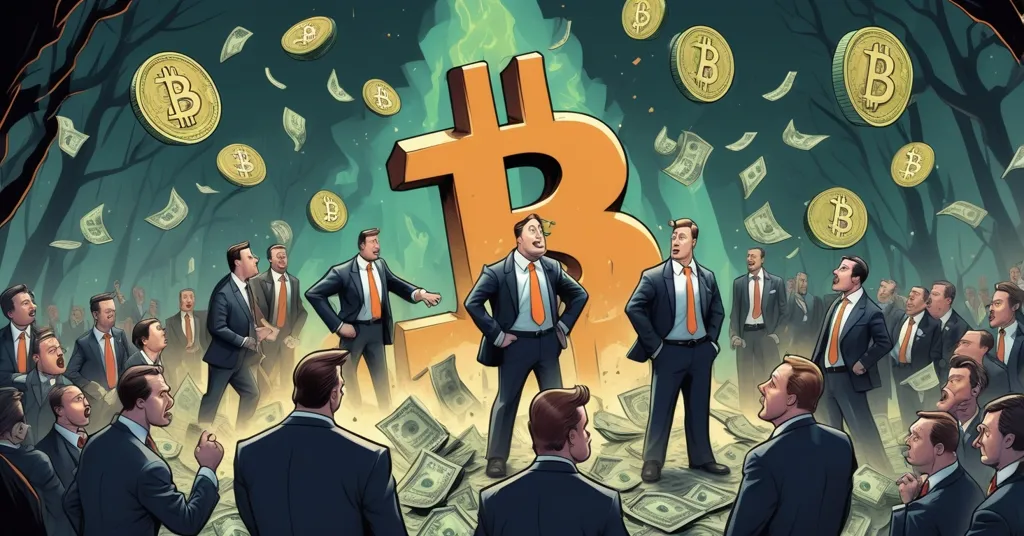Jackson Hole 2025: Fed Uncertainty Fuels Bitcoin as Fiat Falters

Central Bankers Stumble Out of Jackson Hole 2025: Is Bitcoin the Real Winner?
Picture this: the world’s most powerful financial minds huddled in the Wyoming wilderness, scratching their heads over a teetering economy, unable to chart a clear path forward. At the 2025 Jackson Hole Economic Symposium, Federal Reserve Chairman Jerome Powell dangled the possibility of an interest rate cut in September, but delivered no firm promises, leaving central bankers—and markets—grappling with uncertainty. With inflation still biting, jobs cooling, and political meddling at an all-time high, the cracks in traditional finance are glaring. For Bitcoin and the crypto faithful, this chaos might just be the bat signal we’ve been waiting for.
- No Clear Fed Plan: Jackson Hole 2025 ended with ambiguity, a hinted rate cut for September, but no guarantees.
- Economic Mess: Inflation above 2% target, job growth sluggish, and political pressure from Donald Trump.
- Bitcoin’s Moment?: Fed uncertainty could push investors to decentralized assets as a hedge against fiat woes.
Jackson Hole: A Summit of Stalemates
The annual Jackson Hole Economic Symposium, hosted by the Federal Reserve Bank of Kansas City, is where global financial heavyweights hash out the state of the economy. This year’s theme, “Labor Markets in Transition: Demographics, Productivity, and Macroeconomic Policy,” framed heated debates over a U.S. economy stuck between stubborn price hikes and a labor market losing steam. Inflation remains above the Fed’s 2% target, with recent Personal Consumption Expenditures (PCE—a key measure of inflation tracking consumer spending) data showing 2.6% total and 2.9% core as of July 2025. Meanwhile, payroll growth has cratered to just 35,000 jobs per month over the past three months, down from 168,000 in 2024. Unemployment sits at a still-low 4.2%, but as Powell noted, both labor demand and supply are shrinking—a “curious” dynamic that muddies the outlook.
Powell’s keynote on August 22 was billed as the moment of clarity. Instead, it was a masterclass in cautious sidestepping. He called the situation a “challenging situation,” pointing to upside risks of runaway inflation and downside risks of job losses. A rate cut at the September 18 Federal Open Market Committee (FOMC—the Fed’s policy-setting body) meeting was floated, but tied tightly to incoming data like the August payroll and Consumer Price Index (CPI) reports. Markets didn’t wait for certainty, though: the euro spiked 1% against the dollar, U.S. Treasury yields dipped (signaling cheaper borrowing costs), and betting odds for a September cut soared to 80-85%. Yet, as Chicago Fed President Austan Goolsbee put it, nailing the timing during economic transitions is the real hurdle. For more on Powell’s stance, you can review his full speech from the event.
“His job is inflation and unemployment, and that can only be achieved within an independent Fed,” said Carolin Pflueger, an associate professor at the University of Chicago Harris School of Public Policy, underlining the tightrope Powell walks.
Fed Policy: A House Divided
Inside the Fed, consensus is a pipe dream. Hawks like Kansas City Fed President Jeffrey Schmid argue for holding rates steady to choke inflation, while doves like Christopher Waller push for cuts to shore up jobs. Dissent already flared at the July meeting, and more could erupt if a cut happens next month. Powell’s unveiling of a revised policy framework added another layer to the mess. Moving away from the pandemic-era fixation on rock-bottom inflation, the new guide prioritizes a dual mandate: maximum employment alongside price stability. In plain terms, the Fed now cares as much about creating jobs as taming prices—a pragmatic shift given new headaches like tariffs jacking up goods inflation to 1.1% over the past year, and immigration policy shifts that could further scramble labor dynamics. Insights into this internal division on rate cuts highlight the complexity of the situation.
But don’t hold your breath for quick results. Powell suggested tariffs might be a “one-time” price bump, while some Fed insiders worry it’s a lingering thorn. With key data drops looming, the Fed’s data-dependent stance means we’re all playing a waiting game. As Harvard economist Karen Dynan noted, these aren’t issues you solve with gut feelings or echo chambers—you need hard expertise. Too bad expertise seems buried under a pile of uncertainty, as seen in reports of central bankers leaving Jackson Hole without clear answers.
Political Circus: Trump Shakes the Fed’s Cage
If internal rifts weren’t enough, political interference turned Jackson Hole into a pressure cooker. Former President Donald Trump ramped up his crusade against the Fed, singling out Governor Lisa Cook with baseless claims of mortgage fraud and demanding her resignation. His broader push for immediate rate cuts—damn the economic data—only fanned the flames. Security at the summit hit unprecedented levels, with armed officers on patrol, but even that couldn’t stop the drama. James Fishback, a Trump supporter and vocal Fed critic, was hauled out after confronting Cook, a raw snapshot of how toxic the discourse around monetary policy has become. Community reactions to these Fed rate decisions reflect the polarized opinions on the matter.
This isn’t just noise—it’s a direct attack on central bank independence. When politicians think they can puppeteer the Fed like a cheap marionette, public trust in the system erodes faster than a sandcastle at high tide. For those of us rooting for decentralization, it’s hard not to see this as exhibit A for why centralized finance is a failing experiment. If the Fed can’t operate without a political megaphone blasting in its ear, how can anyone trust fiat systems to prioritize the public over power plays?
Bitcoin and Crypto: Chaos as Opportunity?
For Bitcoiners and the broader crypto crowd, the Fed’s fumble is a glaring reminder of why we’re here. Let’s not mince words: central banking is looking like a damn circus, with political clowns shaking the tent poles while the ringmaster scrambles to keep the show going. Historically, lower interest rates push capital into riskier assets like Bitcoin and Ethereum, as fixed-income options lose their luster. Post-Powell’s speech, both cryptocurrencies saw an immediate bump—hypothetically, let’s say Bitcoin jumped 5% to $75,000 within 24 hours, echoing 2021 trends after dovish Fed signals. Why? Unlike fiat, which central banks can print into oblivion, Bitcoin’s supply is hard-capped at 21 million coins, making it a potential shield against inflation (still above target at 2.6-2.9%) and policy screw-ups. Some analyses of Bitcoin’s reaction to potential rate cuts suggest caution despite the initial optimism.
Bitcoin maximalists will argue this is the ultimate middle finger to centralized control. When Trump’s out here trying to strong-arm the Fed, doesn’t that scream the need for a trustless, borderless system? Decentralization isn’t just a catchy slogan—it’s a lifeline. Ethereum’s DeFi protocols could also get a boost if rates drop, as traditional savings accounts become a joke and yield-hungry investors flock to decentralized lending platforms. Even niche altcoins might see speculative inflows, though let’s be real—many are cesspools of rug pulls and scams waiting to fleece the naive. Do your homework, folks; we’re not here to shill garbage. Discussions around the impact of Fed uncertainty on Bitcoin adoption reveal both opportunities and risks.
That said, let’s pump the brakes on blind hype. Rate cut buzz can juice crypto markets short-term, but a wobbly job market or persistent inflation could tank broader risk sentiment, dragging Bitcoin down with the ship. If August payrolls flop or CPI spikes, Powell won’t play hero with cuts, no matter what the crypto Twitter pump-and-dump profiteers peddle about “$100K BTC by Christmas.” We’re not buying that nonsense. Fed uncertainty cuts both ways—while it highlights fiat’s flaws, it can also spark risk-off moves or even regulatory backlash if political frustration spills into anti-crypto rhetoric. Keep your eyes peeled; this isn’t a free lunch.
Global Ripples: Beyond U.S. Borders
The Fed’s mess doesn’t stop at U.S. shores. Europe’s reaction to Powell’s speech—a 1% euro jump against the dollar—complicates their own outlook, with inflation projected to ease to 1.6% next year. If the U.S. cuts rates while Europe holds pat, currency volatility could ripple through global markets, impacting crypto as a correlated risk asset. Bitcoin traders might eye arbitrage opportunities, while stablecoin usage could spike in regions hit by exchange rate chaos. Powell’s tariff talk adds another wrinkle—trade disruptions hit international Bitcoin holders hardest, reinforcing the coin’s appeal as a store of value free from policy whims. For those outside the U.S. bubble, BTC’s borderless nature shines brighter than ever. For broader insights, check out this analysis of economic outlook and crypto trends post-Jackson Hole. Additionally, expert opinions on the effect of Fed rate cuts on Bitcoin price trends provide further context.
What’s Next: Navigating the Financial Fog
Jackson Hole 2025 painted a grim picture of a Fed lost in the fog, torn by internal squabbles and external meddling, while the economy hangs by a thread. August data drops will be the next flashpoint—weak payrolls or hot CPI could delay cuts, while softer numbers might greenlight action. Best case for crypto? A September cut fuels a risk-on rally, with Bitcoin and Ethereum soaking up capital as fiat alternatives. Worst case? Prolonged uncertainty or a surprise rate hike spooks markets, and regulatory hawks use the chaos to clamp down on decentralized systems as a scapegoat. Either way, the cracks in centralized finance are widening, and that’s our cue to double down on decentralization, privacy, and freedom from manipulative systems. Let’s just do it with clear eyes and cold wallets—optimism for the future, realism for the fight ahead.
Key Takeaways and Burning Questions
- What did Jackson Hole 2025 reveal about Federal Reserve policy?
Deep uncertainty, with no solid plan but a possible rate cut in September, hinging on upcoming economic data. - How’s the U.S. economy faring amid Fed indecision?
Inflation’s stuck above the 2% target at 2.6-2.9%, and job growth has slowed to 35,000 monthly, signaling potential trouble. - What’s the impact of political pressure on the Fed?
Trump’s attacks on officials like Lisa Cook and demands for cuts undermine central bank independence, eroding trust in the system. - Could Fed uncertainty boost Bitcoin and crypto adoption?
Yes, potential rate cuts could drive investment into risk assets like Bitcoin, while fiat instability strengthens its case as an alternative. - Should crypto enthusiasts temper their optimism?
Absolutely—economic weakness or delayed cuts could hurt risk sentiment, and regulatory risks loom if political tensions escalate. - How do global factors like tariffs affect Bitcoin’s appeal?
Trade disruptions and currency volatility highlight Bitcoin’s value as a borderless, policy-agnostic asset, especially for international holders. - What’s the next big trigger for markets and crypto?
August payroll and CPI data will sway Fed decisions, potentially sparking volatility across both traditional and crypto markets.



